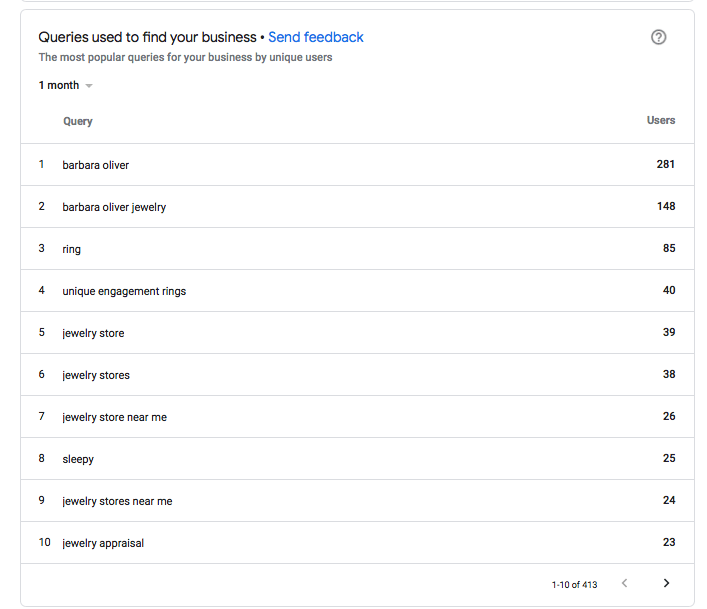Google is constantly updating their offerings, capabilities, and toolsets, and we are here to help you keep up! This update is going to focus on organic with updates ranging from the Speed Update, a new feature addition for 1-click to call in Google Posts, and the addition of search queries in your Google My Business Insights reports. All of these are working in tandem to provide the best user experience possible for users on Google and give them what they want more quickly and easily.
Speed Update

Us marketers are always talking about page speed – it’s just one of those things that matters to Google and your users. Think about it this way, when you are shopping online or looking for a recent news article, you are expecting a site to load fully and quickly, right? Why not think about your site in the same way? Google is looking for speedy fast sites (usually fully loading between 1-3 seconds), and thankfully, this industry keeps up across the board for desktop. But when we look at mobile, the story differs.
Your site loads differently on a phone, both in terms of speed and the layout versus your desktop site, and it’s important to keep an eye on it. In mid-July Google announced they are finally rolling out their Speed Update, and it most importantly affects mobile sites. Thankfully, this update won’t penalize sites that are 0.5-1 second slower week over week, but rather will kill rankings for sites that are extremely slow (and therefore a bad experience for users) on mobile. Running a few tests, with a tool like Google’s mobile speed test, can help you gauge where you stand, and if your site is slower then 5 or 6 seconds to load, you may want to reach out to your web developers to compress images or minimize your Javascript, for example, to speed your site back up!
‘Call Now’ Added to Google Posts

Raise your hands if you love Google Posts; we sure do! They are a handy little tool where you can post information on specials and events off-site right at the top of search results for users with a picture and a call-to-action button. A couple of months ago, we posted a few tips on successes we’ve seen for using Posts for multifamily if you want to take a closer look.
In apartment marketing, the golden ticket is truly your phone number on your website. As a main conversion point, renters can go through a small self-qualification process using points like general pricing, your location, amenities, a pet policy, etc. and then reach out to your leasing team or call center. We’ve seen that it usually takes a few repeat visits to your site before prospects reach out to your team, and thankfully, we can now include your phone number in search results with any pertinent concessions so future renters can give you a ring with just 1 click.
As of last month, Google now allows you to add your phone number as a CTA button on any Google Post, but there is a catch. Unfortunately you can’t add call tracking numbers (which are often used to track your paid campaigns) or any custom phone numbers, but Google will rather pull in your local number listed in your Google My Business information that you inputted prior to verifying your listing. Just a word of warning, if you try to switch your phone number on your listing to change this, there is a chance you may need to reverify it using a postcard, so it’s most likely better to leave it as is – just make sure you have someone in the office to pick up the phone!
Google Search Queries in GMB Insights Reports
Often times, when you look at monthly reporting for your site, you will see internal metrics (think anything from users interacting with your site once they’ve landed on your homepage from search results) like sessions, users, bounce rate, etc., but it’s a great exercise to keep up with how future residents are searching for you in Google before being directed to your site. We often think of this sort of information in two ways: branded and non-branded.
-
Branded: This is when someone knows your property by name. They will usually type in a search like “Villa Club Apartments” and sometimes will even include your city name, and this type of search is great awareness for a lease up property. Often times, users are closer to making a final decision on a new apartment when they use these types of searches.
-
Non-Branded: This is when someone searches for a more general term like “one bedroom apartment in Atlanta”, and this is a fantastic mark of a stable property showing up over competitors. Often times, users are just starting their search looking for some general pricing information, proximity to their work/family & friends/or things to do, and some building details like amenities or pet policy terms. This helps renters to understand their greater market of opportunities in front of them.
As of earlier this month, Google has fully rolled out a new feature in your Google My Business dashboard to view your locations’ queries to see how renters found your property. If you log in to your dashboard, click on your property name, find the “Insights” tab in the left hand menu, and then scroll down the page about halfway, you will see a chart like this:

You can currently view data for the past week or month to get a glimpse into what renters are searching to find you. You will see a mix of branded and non-branded queries, and this data can give you some good insights for some content focus if you’re looking to freshen up your site. Say you are a stable property and you’re seeing mostly branded queries for your property name. Do your meta titles, meta descriptions, and homepage content mention your city name and local area? Try sprinkling some local flavor in so Google can better understand where you are located to make it more likely for you to show in those coveted spots for a great apartment in your area.
Were you aware of these changes in the digital landscape? Want to chat further about how you can try out some of these new tools? We’d love to hear from you!
 $100K Lease-Stakes
$100K Lease-Stakes 





